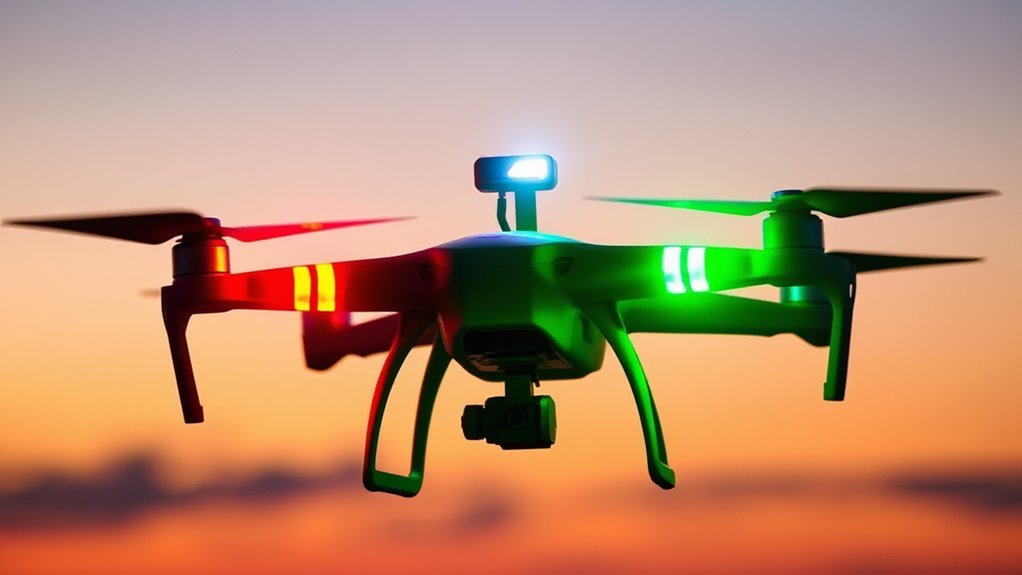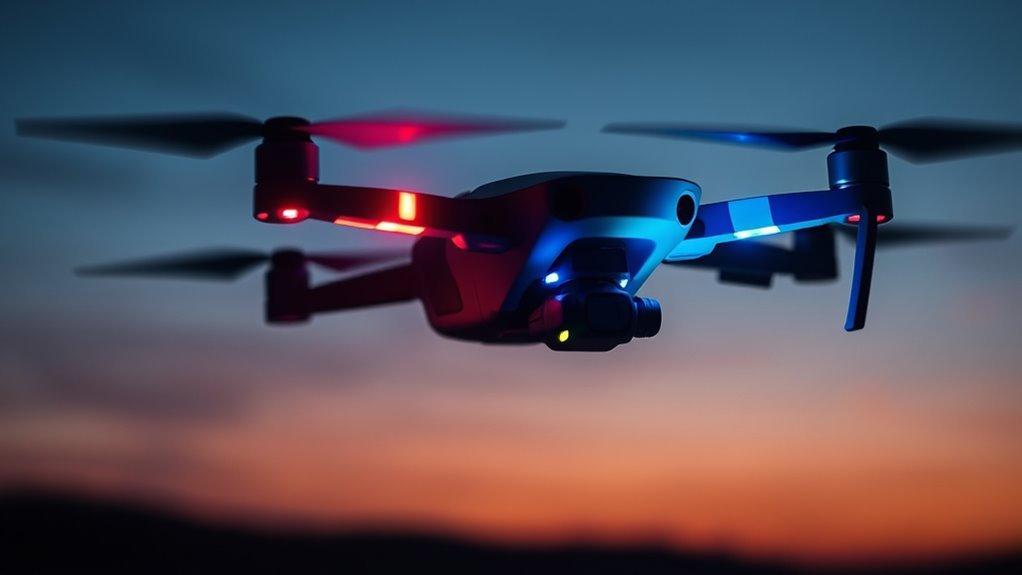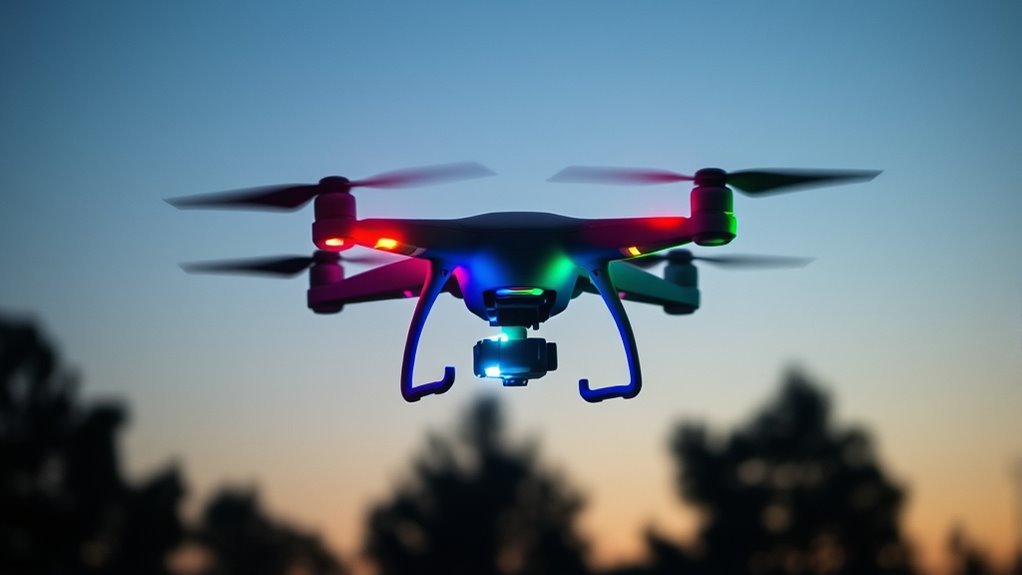Different colored lights on drones convey essential information for safe navigation. Red lights usually indicate low battery or airspace violations, while green lights show that the drone is armed and ready for flight. Yellow lights signal caution, and blue lights define the rear, with white lights used for forward-facing navigation. Recognizing blinking patterns also reveals the drone’s status, such as emergency signals or hovering. Understanding these signals is important for safe operations, and there’s more to uncover.
Understanding Drone Navigation Lights

Understanding the various colored lights on drones is essential for safe navigation and compliance with regulations. Each navigation light type serves a specific drone light functionality. Typically, you’ll encounter white, green, and red lights, each indicating different statuses and movements. The green light denotes the right side of the drone, while the red light signifies the left. White lights often serve as anti-collision or strobe lights, enhancing visibility in low-light conditions. Understanding these light signals not only helps you operate your drone effectively but also guarantees you respect airspace and avoid conflicts with other aerial vehicles. By mastering navigation light types, you gain the freedom to explore the skies confidently while adhering to safety protocols.
The Significance of Red Lights

Red lights on drones serve critical functions in operational safety and compliance. They indicate low battery levels, alert operators to potential airspace violations, and activate emergency signals when necessary. Understanding these signals is essential for maintaining safe drone operation and adhering to regulations.
Indicating Low Battery
A drone’s ability to communicate its operational status is essential for safe and effective flight. When you notice a red light flashing, it’s a vital warning signal indicating low battery life. This alert prompts you to act swiftly, as continued operation could lead to an unexpected shutdown or crash. Understanding this signal empowers you to maintain control and avoid potential damage to both the drone and its surroundings. Effective management of battery life is essential for maximizing flight time and ensuring your drone’s reliability. Ignoring these warning signals could compromise your freedom to explore the skies. Always monitor your drone’s indicators and respond promptly to low battery alerts to preserve your flying experience.
Airspace Violation Alert
When flying a drone, it is crucial to be aware of the airspace regulations that govern where you can operate. Red lights on your drone serve as a critical airspace violation alert. These lights indicate that you’re breaching airspace restrictions, potentially placing you in violation of local laws and regulations. Ignoring this warning can lead to serious violation consequences, including fines, confiscation of the drone, or even legal action. Understanding the significance of these alerts empowers you to navigate the skies responsibly, ensuring your freedom to operate isn’t compromised. Always stay informed about the airspace in your vicinity and heed the warnings your drone provides. This vigilance not only protects your interests but also upholds the safety and integrity of the airspace for everyone.
Emergency Signal Activation
While operating a drone, activating emergency signals is essential for ensuring safety in critical situations. The significance of red lights in this context cannot be overstated. When you encounter an emergency, adhering to established emergency protocols is vital. Red lights serve as a universal indicator of distress, providing signal clarity that alerts nearby operators and observers to the urgency of the situation. This clear communication minimizes confusion, enabling rapid responses to potential hazards. By activating these signals, you’re advocating for your safety and that of others, reinforcing the importance of maintaining control in unexpected scenarios. Ultimately, understanding how to utilize emergency signals effectively empowers you in your pursuit of flight freedom while prioritizing safety.
The Role of Green Lights

Green lights on drones serve essential functions, particularly in enhancing visibility and communication. The green light significance lies in its role as an indicator of the drone’s operational status, often denoting that it’s ready for flight. Additionally, green lights help maintain spatial awareness for both operators and other airspace users. Below is a concise overview of green light functions:
| Function | Description |
|---|---|
| Operational Status | Indicates the drone is armed and ready for flight. |
| Position Awareness | Enhances visibility to prevent mid-air collisions. |
| Ground Control Signal | Communicates with operators during flight maneuvers. |
| Flight Path Indicator | Signals intended direction in complex environments. |
| Safety Assurance | Assures nearby personnel of the drone’s safe operation. |
Understanding these functions can empower you to navigate your drone experience more effectively.
What Yellow Lights Indicate
Following the discussion of green lights, it’s important to examine the role of yellow lights on drones. Yellow lights typically indicate caution or a change in drone operation signals. When you see a yellow light, it may suggest that the drone is entering a restricted area or is experiencing a minor issue that requires attention. Unlike green lights, which signify normal operation, yellow lights serve as a warning, urging you to remain vigilant. Understanding yellow light meanings can enhance your situational awareness, allowing for informed decisions during flight. This knowledge empowers you to maintain control and navigate safely, ensuring that your freedom in the skies isn’t compromised by unforeseen challenges. Always be alert when yellow lights are present.
Blue and White Lights: A Closer Look
When you observe blue and white lights on drones, you’re looking at crucial navigation and positioning indicators. These colors not only enhance safety and visibility but also follow specific color coding regulations that convey important information about the drone’s status. Understanding these functions is essential for both operators and observers to guarantee safe drone operations.
Navigation and Positioning Indicators
While maneuvering through complex environments, drones utilize colored lights as crucial indicators for positioning and orientation. The blue and white lights, specifically, serve as critical navigation light types that enhance your drone’s flight visibility. Blue lights often indicate the drone’s rear, helping you maintain a clear understanding of its direction. In contrast, white lights are typically used for forward-facing navigation, illuminating the path ahead and assisting in spatial awareness. By interpreting these signals accurately, you can enhance your drone’s operational efficiency and safety. Understanding these navigation indicators allows for better maneuverability in tight spaces, ensuring you can freely explore and capture aerial imagery with confidence.
Safety and Visibility Functions
Colored lights on drones serve not only as navigation aids but also play an essential role in safety and visibility. Blue and white lights enhance visibility, ensuring your drone’s presence is noticeable in various environments. This visibility enhancement is vital for avoiding collisions and ensuring compliance with safety measures.
- Blue lights often indicate emergency or special operations.
- White lights serve as a general indication of drone activity.
- Enhanced visibility helps in low-light conditions and adverse weather.
- Proper use of colored lights promotes responsible drone operation.
Color Coding Significance
Understanding the significance of blue and white lights on drones is essential for effective operation and compliance with regulations. Blue lights typically indicate a drone’s status as an active UAV, often used for law enforcement or emergency services, while white lights signify the drone’s position and orientation during flight. The color significance here is vital; each hue conveys specific light meanings that inform both operators and observers about the drone’s function and intent. For instance, if you see a blue light, you might expect authorized personnel are operating the drone. Recognizing these color codes empowers you to navigate airspace responsibly, ensuring safety and compliance while enjoying the freedom that drone operation offers.
Patterns of Blinking Lights
Numerous drones employ specific patterns of blinking lights to convey information, enhance visibility, and guarantee safety during flight operations. Understanding these blinking patterns and light sequences can empower you to interpret the drone’s actions and intentions effectively.
- Steady Blinking: Indicates active flight mode.
- Rapid Blinking: Signals an emergency or low battery.
- Alternating Colors: Denotes a change in direction or altitude.
- Slow, Pulsing Light: Suggests the drone is in standby or hovering mode.
Regulatory Requirements for Drone Lights
While regulatory requirements for drone lights can vary by region, compliance is essential for ensuring safe operations in shared airspace. Understanding the specific drone regulations in your area is vital; many jurisdictions mandate the use of colored lights for visibility and identification. For instance, some require flashing lights during nighttime operations to prevent collisions. Light compliance not only enhances safety but also promotes accountability among operators. You’ll need to stay informed about updates to these regulations, as non-compliance can lead to fines or restrictions on your flying privileges. Ultimately, adhering to these requirements enables you to maximize your freedom to operate drones while contributing to a safer aerial environment for all users.
Safety Tips for Recognizing Drone Lights
How can you effectively recognize drone lights in your vicinity? Understanding drone visibility tips is essential, especially during nighttime flying. Here are some strategies to enhance your awareness:
Recognizing drone lights is crucial for nighttime awareness; learn to interpret colors and patterns for safety.
- Know the color meanings: Red typically indicates left, green for right, and white for the rear.
- Observe light patterns: Steady lights may signal hovering, while flashing indicates movement.
- Consider altitude and distance: Drones at higher altitudes may appear less distinct; use binoculars for clarity.
- Stay informed: Familiarize yourself with local drone regulations to understand operational zones.
Frequently Asked Questions
Can Drone Light Colors Vary by Manufacturer?
Colors dance in the sky, and yes, drone light colors can vary by manufacturer. Each design follows specific manufacturer specifications, utilizing color coding to convey operational status, enhancing your understanding of the drone’s functionality and intentions.
How Do Weather Conditions Affect Drone Light Visibility?
Weather conditions greatly impact light performance. Fog, rain, or snow can obscure visibility, reducing your drone’s effectiveness. It’s essential to assess weather impacts before flying to guarantee safe, reliable operation and maintain control over your device.
Are There Specific Colors for Different Drone Types?
When considering drone color significance, it’s essential to understand that light color meanings vary by type. For instance, green often indicates a ready state, while red may signify low battery or operational issues.
Can Drone Lights Indicate Battery Levels?
Imagine flying your drone, and it suddenly flashes red. This light color indicates low battery levels, serving as an essential battery level indicator. Understanding light color meanings can enhance your flying experience and guarantee safe landings.
What Should I Do if I See Unusual Drone Lights?
If you notice unusual drone lights, document the details and check local drone regulations. Reporting unusual sightings helps authorities guarantee safety and compliance, promoting responsible drone use while protecting your freedom and airspace integrity.

